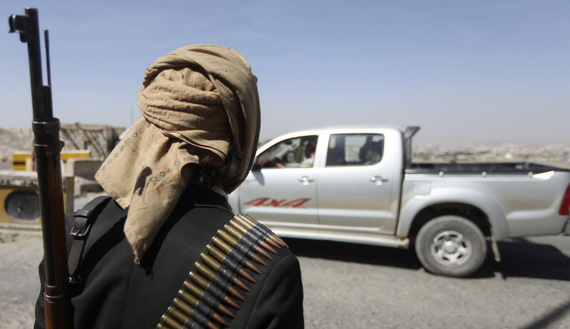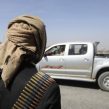
Iranian Perspectives on Yemen’s Houthis
Publication: Terrorism Monitor Volume: 13 Issue: 13
By:

A central element in the ongoing crisis in Yemen is the perception among Sunni-led states that Iran is playing a central role in supporting the Houthi Shi’a rebel movement militarily and politically, and fear of growing Iranian influence in Yemen has been a key factor behind the ongoing Saudi-led military airstrikes in the country (Entekhab [Qom], April 9). Less well-known, however, is the evolution of Iranian public attitudes and statements to the country, and particularly towards the Houthis, who hail from the minority Zaydi branch of Shi’a Islam, which differs substantially from the “Twelver” form of Imami Shiism observed by Iran’s rulers. This article aims to illustrate some key developments in Iranian attitudes toward Yemen in recent years.
Until early 2015, Iran, by and large, publicly denied any interference in the Yemeni conflict. For instance, in April, Iranian Deputy Foreign Minister for Arab and African Affairs Hossein Amir-Abadollahian described the official position of the Islamic Republic as: “Iran is not interfering in Yemen at all and has no military forces or even military advisers for training affairs in Yemen. And what defense tactic the Yemenis adopt against the Saudi aggression is a completely internal issue” (Press TV, April 17).
However, in recent months this stance has subtly changed, and—although the government continues to deny an official link—a number of Iranian officials have not only expressed solidarity, but also implied some form of an Iranian support for the Houthis. For example, a January 25, 2015 statement by the representative of the Supreme Leader Ali Khamenei in the Quds Force of Iran’s Revolutionary Guard Corps (IRGC), Hojjal Eslam Ali Shirazi, is perhaps one of the strongest suggestions of cooperation with the Houthis by an Iranian official:
Although Shirazi’s statement did not explicitly say that Iran had supported the Houthis, his statement clearly opened the door to such an interpretation by comparing the group with overtly Iranian-backed and trained movements in Lebanon, Iraq and Syria. His statement, however, came just days after fighting in Yemen’s capital, Sana’a, led to a victory by the Houthi rebels and forced the internationally-recognized administration of Abd Rabbu Mansur Hadi to flee to the southern city of Aden. Shirazi’s remarks may have been an attempt to take credit for this development, whether deserved or not (Al-Monitor, January 22). Similarly, Brigadier General Ismail Qaani, the Quds Force deputy commander, gave a speech in May describing the Houthis as an Iranian ally, although again providing no specifics of what form this alliance actually takes, a formulation that allows Iran to receive the credit for the Houthis’ expansion without necessarily taking full responsibility (al-Arabiya, May 24).
Similarly, Iranian statements on Yemen show that motivations for declaring support for the Houthis vary. For example, in June 2015, Ayatollah Muhammad Ali Taskhiri, a high-ranking Shi’a cleric in Qom, described the Houthis’ victory as a step towards destroying what he described as an al-Qaeda-Saudi alliance (IRNA, June 7). On the other hand, Ali Mosavi Nejad, a conservative Iranian analyst, has described the Houthis as playing an integral role in advancing the Shi’a cause in the region, while even suggesting that the Yemenis and the Iranians maintain historic ties that date back centuries (Hawzanews, April 22). In other instances, religious and messianic elements play a key role. For instance, on many popular media and blogs, rumors of the Mahdi’s return from Yemen are abundant. [1] The most quoted saying in this regard comes from the late Ayatollah Mohammad-Taqi Behjat (1915-2009), who reportedly called on Shi’as to pay attention to Yemen; he said a spark will come from that country that signals the return of the Lord of Time (Sahib az Zaman), even though an official website run by his followers has issued a denial of such predictions (Elyaselays.blogfa.com, January 21). [2] While it is highly unlikely that such messianic fervor is playing any significant role in Iran’s policy decisions, popular beliefs may encourage Iranian officials to publically talk about Yemen because they know that this plays well with their domestic religious base.
In the same way, Hezbollah of Lebanon has also sought to suggest that it has also assisted the Houthis. For instance, al-Akhbar, a newspaper close to Hezbollah, has reported that the Houthis had acquired anti-aircraft missiles and rockets from the Lebanese group, including Fajr 5 artillery rockets supplied by Iran to Hezbollah forces in 2006 (Shi’a News, June 13). Similarly, Hezbollah’s secretary-general, Hassan Nasrallah, has praised the Houthis military advances against the Saudis (Sarbazgomnam08.ir, April 18; Shi’a News, June 13). At the same time, however, it is likely that such claims and expressions of support are at least partly aimed at shoring up Hezbollah’s domestic Shi’a support-base in Lebanon, rather than necessarily always indicating Hezbollah’s material support for the Houthi movement.
In terms of the Houthis’ actual relations and links with Iran, much remains unclear. On one hand, Iran’s official media has suggested that the Houthis’ relations with Iran goes back to the early 1990s when Hussein al-Houthi, the founder of the movement, publically expressed admiration for Ayatollah Khomeini and the Iranian revolution (Fars News, June 4, 2013). Indeed, there is some evidence that the Houthis have admired the Islamic Republic and sought to establish close ties in order to participate in broader pan-Shi’a regional politics. Religious contact between Houthis and Iran have also expanded a distinct Shi’a transitional network, with Qom as the Shi’a cultural and learning center. [3] However, the actual scope of Iranian Imami religious influence on the Zaydi Houthis remains unclear. Moreover, there is no evidence that the IRGC has command and control over the Houthis, and its interaction appears limited to advising, training and supply of weapons.
Sunni Arab states may be right to suspect that Iran is materially backing the Houthis, given Iran’s consistent promotion of what it sees as Shi’a interests in the region since the 1979 revolution, though this has still been dependent on political factors on the ground and the extent to which Iran can enhance its sphere of influence via such interventions. Iran’s intentions in supporting the Houthis are likely twofold: first, in the hope that Yemen could provide an alternative ally if Bashar al-Assad’s rule in Syria crumbles, and secondly, the geo-strategic position of Yemen could provide a base for Iran to pressure and contain Saudi and Salafist influence in the Arabian Peninsula. Despite this, Yemen remains a low priority for Iran, especially compared to Lebanon, Iraq and Syria, countries in which Iran has invested major economic, military and political capital throughout the last decade. In this context, comments by Iranian officials in support of the Houthis should generally be understood as more rhetorical than substantial, and yet these statements reflect a confrontational stance that fuels tension in a region already embroiled in conflict.
Nima Adelkhah is an independent analyst based in New York. His current research agenda includes the Middle East, military strategy and technology, and nuclear proliferation among other defense and security issues.
Notes
1. In Shi’a eschatology, the Mahdi (or the “guided one”) is a messianic figure who will return at the end of time, before the Day of Judgement, in order to bring justice back to earth. According to Twelver Shi’as, the Mahdi, or Muhammad Ibn al-Hasan al-Mahdi, is the twelfth imam, who went into occultation in 873-874, and his reappearance will be signaled by prophetic signs such as natural disasters or major conflicts.
2. The official site of Ayatollah Behjat has denied such rumors. One example of this was posted on March 29, 2015 at https://shayeaat.ir/post/206.
3. See a translation of an interview with Zaydi cleric Issam al-Imad from September 28, 2009 at https://mesi.org.uk/ViewNews.aspx?ArticleId=3442.





